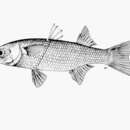Diagnostic Description
provided by Fishbase
Diagnosis: body stout, rounded in cross-section; head broad; inter-orbital space flat; a well developed adipose eyelid covering most of pupil (Ref. 57400). Upper lip simple, thicker and deeper than in most Mugil species, armed with 2-3 rows (Ref. 57400), teeth in outer row curved, monocuspid (Ref. 57400, 81659) and moderately close-set (Ref. 81659) or widely spaced (Ref. 57400), inner row of less closely set, smaller teeth may be present just posterior to outer row (Ref. 81659). Lower lip with single row of unicuspid teeth, usually smaller than teeth in outer row on upper lip (Ref. 81659). A vertical line from hind end of upper jaw positioned midway between posterior nostril and anterior eye margin; maxillary pad not visible below corner of mouth when closed; origin of 1st dorsal fin equidistant from snout tip and caudal-fin base; pectoral axillary process well developed (30-37% of pectoral-fin length)(Ref. 57400). (Second) dorsal and anal fins entirely (and more or less densely) covered with scales (Ref. 57400, 81659). Anal fin usually III-9 (rarely III-10) in adults (usually II-10 in juveniles
- Recorder
- Grace Tolentino Pablico
Migration
provided by Fishbase
Catadromous. Migrating from freshwater to the sea to spawn, e.g., European eels. Subdivision of diadromous. Migrations should be cyclical and predictable and cover more than 100 km.
Morphology
provided by Fishbase
Dorsal spines (total): 4 - 5; Dorsal soft rays (total): 8 - 9; Analspines: 3; Analsoft rays: 9 - 10
- Recorder
- Grace Tolentino Pablico
Trophic Strategy
provided by Fishbase
Inhabit sandy coasts and littoral pools but also occurs in muddy bottoms of brackish lagoons and estuaries. Sometimes penetrate rivers. May also be found on coral reefs (Ref. 9710). Juveniles are common in coastal waters and are known to find their way to estuaries and coastal lagoons. Growth in juveniles is moderate (30-40 cm in 4 years). Feed on microscopic or filamentous algae and small juveniles of planktonic organisms (Ref. 9626). Juveniles and adults both feed on algae and detritus (Ref. 26987, 33). Herbivore (Ref. 40102). Mud-eaters that swim near the bottom when feeding, and scoop up and ingest portions of substrate containing their food (Ref. 40396).
Biology
provided by Fishbase
Inhabit sandy coasts and littoral pools but also occurs in muddy bottoms of brackish lagoons and estuaries. Sometimes penetrate rivers. May also be found on coral reefs (Ref. 9710). Juveniles are common in coastal waters and are known to find their way to estuaries and coastal lagoons. Growth in juveniles is moderate (30-40 cm in 4 years). Adults form schools (Ref. 9321). Feed on microscopic or filamentous algae and small juveniles of planktonic organisms (Ref. 9626). Reproduction occurs between March and August. Spawn several million eggs provided with a notable yolk (Ref. 35237). Oviparous, eggs are pelagic and non-adhesive (Ref. 205). Maximul size 910 mm TL for western Central Atlantic specimens, eastern Central Atlantic specimens may reach 350 mm TL and commonly reach 250 mm TL (Ref. 81659). An important foodfish, it is marketed fresh and salted (Ref. 9321).
Importance
provided by Fishbase
fisheries: commercial; aquaculture: commercial; bait: occasionally
White mullet
provided by wikipedia EN
The white mullet or silver mullet (Mugil curema) is a tropical and subtropical marine fish of the family Mugilidae. It is commonly about 30 cm long.[2]
Note that silver mullet is also a common name used for fantail mullet (Mugil gyrans).
Distribution and habitat
The white mullet is an Atlantic and Pacific fish mainly found on American coasts. In the Western Atlantic it ranges from Argentina to Cape Cod and rarely even up to Nova Scotia. In the Eastern Atlantic it occurs from Namibia to Senegal, and in the Eastern Pacific from Chile to the Gulf of California.[2]
The white mullet is found along sandy coasts and in littoral pools, but also occurs in brackish lagoons and estuaries on muddy substrates and sometimes even in rivers. Juveniles in particular invade estuaries and coastal lagoons. Adults occur in schools.[2]
Atlantic USA
In the US, owing to their small size (less than 12 inches), white mullet are primarily used for bait. In some parts of Florida and southern Alabama, they are occasionally eaten in the place of the much larger striped mullet (or flathead mullet) (Mugil cephalus). Adult white and striped mullet consume the mud found on the bottom of estuarine waters, digesting the algae, plankton, and plant and animal detritus therein. These mullet are unique in having a muscular gizzard. They are an important part of the ecologies of estuarine and coastal waters of the Gulf and Atlantic coasts of America.
References

- license
- cc-by-sa-3.0
- copyright
- Wikipedia authors and editors
White mullet: Brief Summary
provided by wikipedia EN
The white mullet or silver mullet (Mugil curema) is a tropical and subtropical marine fish of the family Mugilidae. It is commonly about 30 cm long.
Note that silver mullet is also a common name used for fantail mullet (Mugil gyrans).
- license
- cc-by-sa-3.0
- copyright
- Wikipedia authors and editors
Diet
provided by World Register of Marine Species
Feeds on microscopic or filamentous algae and small juveniles of planktonic organisms
North-West Atlantic Ocean species (NWARMS)
- license
- cc-by-4.0
- copyright
- WoRMS Editorial Board
Distribution
provided by World Register of Marine Species
Western Atlantic: Nova Scotia, but uncommon north of Cape Cod, Bermuda, and northern Gulf of Mexico to southern Brazil
North-West Atlantic Ocean species (NWARMS)
- license
- cc-by-4.0
- copyright
- WoRMS Editorial Board
Habitat
provided by World Register of Marine Species
nektonic
North-West Atlantic Ocean species (NWARMS)
- license
- cc-by-4.0
- copyright
- WoRMS Editorial Board
Habitat
provided by World Register of Marine Species
Inhabits sandy coasts and littoral pools but also occurs in muddy bottoms of brackish lagoons and estuaries. Sometimes penetrates rivers. May also be found on coral reefs.
North-West Atlantic Ocean species (NWARMS)
- license
- cc-by-4.0
- copyright
- WoRMS Editorial Board

